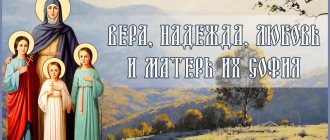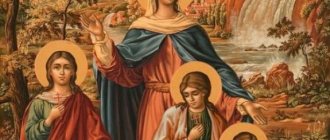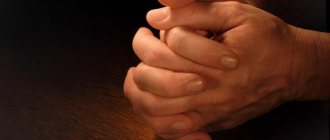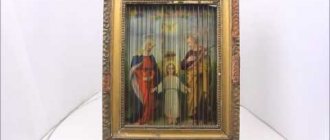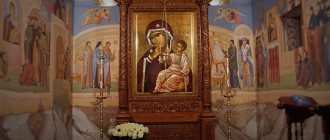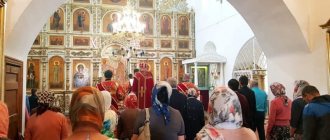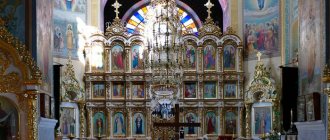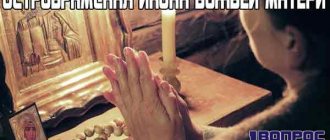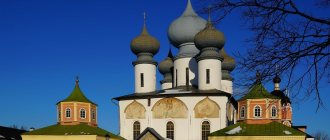The first centuries of Christianity, accompanied by Roman persecutions, gave the Church many role models. The icon “Faith, Hope, Love and their mother Sophia” depicts a family that suffered torment for confessing Christ as the Savior and Son of God. The icon is considered the patroness of the hearth and personifies the unanimity that should exist between members of the same family.
About the author About the book
History of the icon “Faith, Hope, Love and their mother Sophia”
To understand how the icon “Faith, Hope, Love” arose, you need to familiarize yourself with the history of pious virgins - according to our concepts, they were still children. Sofia, their mother, managed to convey to the girls a love for God and His commandments; they often spent time together in prayer.
A family lived in what is now Italy, then ruled by the cruel Emperor Hadrian. He is known for his atrocities against anyone who did not worship pagan idols. The secret Christian women who then traveled throughout the empire to spread the Word of God attracted attention, and a denunciation was drawn up. The ruler personally wanted to look at the unusual confessors and ordered them to be brought to his chambers.
Work as a courier at Yandex.Eda (up to 3,400 rubles per shift) leave a request →
Although the girls were very young (the youngest was 9, the eldest was 12), they perfectly understood why they were going to the palace. They did not rebel against fate, they only begged Christ to give them the strength to worthily bear their martyr’s cross. At first, Andrian tried to use a trick - he tried to prove by force of persuasion that it was better to abandon the Christian faith.
But the girls stood their ground, recognizing only Christ as God, refusing paganism. They did not even want to pretend that they were worshiping pagan statues - for this the emperor promised to let them live in the palace. But to all persuasion the torturers received a negative answer. Then they were given over to be tortured, and the mother was forced to watch, trying to at least force her to renounce Christ.
- They began to torture Pistis (Vera) first, but during the torture she did not utter a word, and only before her head was cut off did she promise to pray for her mother and sisters.
- It was Elpis’s (Nadezhda) turn - they began to beat her severely, then sent her into a burning oven. Seeing that the fire did not harm the girl, the emperor ordered her head to be cut off.
- The younger Agape (Love) was mutilated beyond recognition before her execution.
- To hurt Sofia more painfully, Andrian pardoned her, and even gave up the bodies and heads of his murdered daughters. Near their graves she quietly departed to the Lord.
History of origin
The story through which we learned about the three sisters and their mother Sophia began at the end of the 2nd century AD. Then still young Sophia married a pagan Roman, who loved his wife so much that he did not insist on changing his religion. Years passed, three wonderful daughters were born, who were raised as diligent, believing Christians.
By a sad coincidence, the girls' father died, leaving them without any protection. These were troubled times when Christians were still subject to persecution and cruel torture if there was no one to stand up for them. This fate did not spare the poor woman and her children, whom the emperor himself called to bow to him. In those years, the Roman government gave preference to pagan gods, and the presence of a Christian family on its lands was considered a challenge to their foundations and traditions.
Despite suspicions of impending intrigues, Sophia and her daughters appeared before the face of the emperor, who ordered the children to renounce their faith. He tempted them with various speeches, offering money, beautiful things and sweets. The girls, despite their young age, turned out to be adamant, which infuriated the ruler.
He ordered the torture of the eldest of the sisters, whose name translated into Slavic meant Vera. The girl steadfastly endured the tortures inflicted on her, and some of them did not even leave marks on her skin. This was perceived as a blessing from God, which infuriated the emperor.
He ordered the eldest girl's head to be cut off, after which he moved on to torture the younger sisters. They turned out to be no less persistent, ending their days on the executioner’s block without ever renouncing Jesus Christ. It was the girls' mother who had the hardest time, since all the torture took place before her eyes. The emperor ordered the woman herself to be released, giving the bodies of the children for burial.
The mother died a couple of days after the funeral, without surviving the grief. For the unshakable steadfastness and courage shown by the young girls in the face of the executioners, they were ranked as saints, dedicating a separate icon to the family.
The meaning of the icon “Faith, Hope, Love and their mother Sophia”
Sofia was a wise woman; she gave her children names that also mean the most important human spiritual qualities. Every Christian should cultivate them in himself. Therefore, the meaning of the icon depicting Faith, Hope, Love and their mother is to remind us of eternal values, which often become less important for people than earthly, transitory joys.
- Hope is a feeling of calm trust that God's mercy has no limits.
- Faith is what connects man and God since the Fall - after all, in paradise, Adam could directly see the Creator and speak with Him.
- Love is the basis of Christian existence, the force on which the world rests. This should also be the determining factor in a person’s relationship to God and to everyone around him (Christ commanded to love even enemies).
Signs
- If the cranes take flight, the cover will be frosty.
- The finch flies and carries the cold.
- If a hedgehog's nest (lair) is built in the middle of the forest, then the winter will be severe.
- If an early squirrel has a blue coat, then spring will be early.
- If the squirrel begins to shed from bottom to top, then the winter will be cold.
- If thunder thundered, autumn will be warm and long, and winter will be late.
- Whoever sheds tears in the morning protects his family.
- If it rains on this day, it will be early spring.
- Women should not do household chores.
- September 30 is considered a dangerous and unlucky day.
- On this day, a woman should cry in the morning about herself, about her female lot, about her family and friends, about her home to ease her soul.
- After Faith, Hope, Love, the first frosts begin.
- They marry on Vera, Nadezhda, and Love, and they hold a wedding on the Intercession.
- Hope, Nadezhda, for good, but expect bad.
- If the cranes fly on this day, then there will be frost on Pokrov, but if not, then winter will be later. Usually they shouted after the cranes: “The road is like a wheel,” so that in the spring they would return to their native places.
Folk omens say that this day is always cold and rainy.Weddings, engagements and weddings are not held on September 30 - a bad omen.
How to recognize the icon of the Great Martyrs?
Since the holy martyrs lived in the 2nd century, the veneration of their image has a long history. They are depicted frontally, with Sofia standing behind the short daughters. As a rule, everyone holds crosses in their hands - this is a symbol of the Savior’s great sacrifice. It also signifies martyrdom.
Often the icon “Faith, Hope, Love and their mother Sophia” looks very colorful - the girls wear vestments of different colors (red, white, azure, sometimes green and yellow are used). In some images they are dressed like priests. The style of depicting the faces depends on the time of execution of the icon and the school to which the icon painter belonged. But the family is always together, as a worthy role model.
- There is a well-known image in which children of different heights, the youngest holds an unrolled scroll in her hands, the eldest - the Gospel, the middle - a wooden cross. The mother hugs her daughters by the shoulders, everyone looks straight ahead, as if telling those praying that their main asset was the Christian faith. Behind the martyrs one can see mountains, and above there is a blue sky with cirrus clouds.
- In more traditional images of the Byzantine school, the holy virgins hold Orthodox eight-pointed crosses in their hands, their mother stands with her hands raised to the sky in prayer - she asks for God's help. The faces of the saints are calm, their heads are bowed, as if in agreement with the will of God, who has prepared trials for His children.
- There is also an icon with stamps depicting scenes from the life of St. Sophia and her children study the Holy Scriptures, in another they appear before the ruler, then have a conversation with a pagan priestess. Next come scenes of the torment of each of the sisters, then the burial. In the center is a classic frontal image of the whole family.
Temples in the name of saints
Become a courier of the Yandex.Food service right now (up to 3,400 rubles per shift) leave a request →
Relics of St. Sophia and her daughters were kept in France (Esho), in the abbey named after her. They were solemnly brought from Rome in the 8th century. The shrines attracted so many pilgrims that a hotel had to be built for them. After the French Revolution, the shrines disappeared - apparently, they were destroyed. The saints suffered at the hands of those who deny any faith. The monastery itself became a tavern.
The revival of the monastery began already in the 20th century, when it was possible to obtain more particles of the relics of St. Sofia. The remains of the holy virgins are lost forever.
In Russia, the church of the icon “Faith, Hope, Love and their mother Sophia”, which is located in the patriarchal courtyard, is very famous. It is part of the Trinity Deanery of Moscow. The temple is located near the Miussky field. Here is a cemetery where merchants and townspeople from the surrounding areas found their last refuge.
At the beginning of the 19th century. St. served here many times. Tikhon, who was then Patriarch. Two chapels, bell towers, and a refectory were added to the main building. In the 30s, the church was looted and closed. In the 90s, a revival began, and the Patriarchal Compound is located here again. It was even possible to recreate the former appearance of the temple; the walls are decorated with paintings.
On the entrance arch there is a mosaic image of holy virgins with crosses in their hands, behind them the mother stands and supports the girls. Restored from ruins, the church today is the center of parish life, where there is a Sunday school, a youth club, and catechetical courses.
Prayer to the icon of the Mother of God of Blachernae
July 20 (July 7, old style)
This icon from the Blachernae Temple in Constantinople laid the foundation for the iconography “HODIGETRIA,” that is, the Guide. According to legend, it was with this icon of the Mother of God that Patriarch Sergius (610 - 631) walked around the walls of Constantinople with prayers in 626 during the siege of the capital by the Avars. In memory of this and other victories won thanks to the intercession of the Blessed Virgin, it was established annually on Saturday of the fifth week of Great Lent to celebrate the Feast of the Praise of the Blessed Virgin Mary (“Saturday of Akathist”).
Initially, the celebration took place only in the Blachernae Temple in Constantinople. In the 9th century, the holiday was included in the charter of the monastery of St. Savva the Sanctified and in the Studite charter, and then included in the Lenten Triodion and became common to the entire Orthodox Church.
In 1654, the Blachernae icon was brought to Moscow as a gift to Tsar Alexei Mikhailovich.
According to one version, after the fall of Constantinople, the holy image came to Athos and it was the Athonite monks who transferred it to Moscow. According to another, after the capture of Constantinople by the Turks, the icon was transferred to a convent in the name of Christ Pantocrator. When the conquerors turned the monastery church into a mosque, Christians walled up the holy image along with church utensils in a blind window. For more than a hundred years, the shrine was located in a walled niche until it was discovered in 1616. The icon of the Mother of God was somehow given to Christians, and after that they sent it as a gift to the Tsar of Moscow.
The icon is a relief bust image of the Virgin Mary. On Her left hand is a high-seated Baby, blessing with two fingers and holding a rolled scroll in the other.
“She is not painted with paints, but as if bodily or depicted with mastic, for parts of Her body protrude strongly from the surface of the board, to the great surprise of the beholder, inspiring awe,” wrote Pavel of Aleppo, describing the visit to Moscow in early 1655 of the Patriarch of Antioch Macarius .
The ancient Byzantine shrine, presented as a gift, was located in the Assumption Cathedral of the Kremlin for more than two centuries. In 1918, the icon was transferred from the cathedral, which was closed for prayer, to the Church of the Exaltation of the Cross on Vozdvizhenka. After the destruction of this temple in 1931, the miraculous image was taken to the Kremlin for inclusion in the collection of the State Kremlin Museums. The Orthodox shrine is still part of this collection.
It is known that at the same time as this shrine, another Blachernae icon of the Most Holy Theotokos was brought to Moscow. Currently it is in the Tretyakov Gallery.
According to legend, it was written by the Evangelist Luke and was first in Antioch, then in Jerusalem, and from the middle of the 5th to the 8th century it was in Constantinople in the Blachernae Temple, where it became famous for many miracles. This holy icon is also called Hodegetria, that is, the Guide. It was with this icon that Patriarch Sergius (610-631) walked around the walls of Constantinople with prayer services during the siege of the capital by barbarians in 626. In memory of this and other victories won thanks to the intercession of the Blessed Virgin, it was established annually on Saturday of the 5th week of Great Lent to celebrate the Praise of the Blessed Virgin Mary (Saturday of the Akathist).
Initially, the celebration took place only in the Blachernae Temple in Constantinople. In the 9th century. the holiday was included in the charter of the monastery of St. Savva the Sanctified (532; memory 5/18 December) and in the Studite charter, and then included in the Lenten Triodion and became common to the entire Orthodox Church.
During the iconoclastic persecution in the 8th century. pious people hid the icon in the wall of the monastery of Pantocrator (Almighty), where it remained for almost a hundred years, tightly covered with stones. By special order of the Mother of God, the icon was found and triumphantly transferred to its original place in the Blachernae Church.
We advise you to study Prayers to St. Nicholas the Wonderworker for good luck and luck
After the capture of Constantinople by the Turks in 1453, the Blachernae icon was transferred to Athos, and in 1654 it was sent by Athos monks to Moscow as a gift to Tsar Alexei Mikhailovich. In Moscow, Patriarch Nikon met the icon and placed it in the Assumption Cathedral.
Also read on our website:
Icons of the Mother of God - Information about the types of icon painting, descriptions of most icons of the Mother of God.
Lives of Saints – Section dedicated to the Lives of Orthodox Saints.
For the beginning Christian - Information for those who have recently come to the Orthodox Church. Instructions in spiritual life, basic information about the temple, etc.
Literature – Collection of some Orthodox literature.
Orthodoxy and occultism - Orthodoxy's view of fortune-telling, extrasensory perception, the evil eye, corruption, yoga and similar “spiritual” practices.
How does the icon “Faith, Hope, Love and their mother Sophia” help?
A prayer offered near the icon of “Faith, Hope, Love” will help:
About the author About the book
- protect the family from divorce;
- build a strong relationship with your spouse;
- will protect you from envious people;
- will return lost love;
- will help unmarried people choose a groom;
- relieve hand diseases;
- will help you get rid of the burden safely.
Even when everyone is healthy, you can ask for good health for your children and relatives. People who have suddenly lost loved ones find relief in prayer. The famous copy of the icon “Faith, Hope, Love and their mother Sophia” is located in the Novodevichy Convent (Moscow), made at the end of the 17th century. K. Zolotarev. If you can’t get there, the icon can be purchased at any church shop, then you can turn to the saints at any time.
- Icon of Gerontissa
- Vladimir Icon of the Mother of God - here
- Icon “It is worthy to eat” -
Previously, the holiday in honor of the martyrs lasted three days, but today everyone who bears these names is congratulated on the last day of September. Folk memory has preserved the traditions that were observed on this holiday. Women were supposed to start the day with tears - this is a kind of amulet against adversity. Young people organized festivities where they could look for a groom. This day was considered suitable for sending matchmakers. And the married women prayed for peace to reign in the house.
What can you pray to the Saints for?
Many Orthodox believers turn to the Holy Great Martyrs with prayers, requests for help and gratitude. First of all, they pray to this icon for the well-being of the family.
- about easy childbirth, the speedy conception of children;
- about the well-being of the family;
- about peace in the family;
- about creating strong family ties;
- about strengthening faith in the heart;
- about healing from gynecological diseases and other ailments;
- about the Lord protecting from ill-wishers.
Prayer to the holy martyrs Vera, Nadezhda, Lyubov and their mother Sophia
O holy and praiseworthy martyrs Vero, Nadezhda and Lyuba, and valiant daughters, wise mother Sophia, I now come to you with fervent prayer. What else will be able to intercede for us before the Lord, if not faith, hope and love, these three cornerstone virtues, in which the image is called, you are the most prophetic! Pray to the Lord, that in sorrows and misfortunes He may cover us with His indescribable grace, save us and preserve us, as the Lover of Mankind is good. That glory, like the never-setting sun, is now radiantly visible; assist us in our humble prayers, that the Lord God may forgive our sins and iniquities, and may He have mercy on us, sinners and unworthy of His generosity. Pray for us, holy martyrs, our Lord Jesus Christ, to Him we send forth glory with His Beginning Father and His Most Holy and Good and Life-Giving Spirit, now and ever and unto ages of ages. Amen.
Troparion of the martyrs Faith, Nadezhda, Lyubov and their mother Sophia
voice 4
The Church of the first-born triumphs, / and the mother rejoices in receiving the joy of her children, / like the wisdom of the same name / with the triple theological virtue of the equal race. / You and the wise virgins behold the ignorant Bridegroom of God the Word, / with her, we too rejoice spiritually in their memory, saying: / Champions of the Trinity, / Faith, Love and Hope, / strengthen us in faith, love and hope.
Kontakion of the martyrs Faith, Nadezhda, Lyubov and their mother Sophia
voice 1
Honest Sophia's most sacred branches/ Faith and Hope and Love appeared,/ wisdom was filled with Hellenic grace,/ both the sufferer and the victorious one appeared,// tied to the Lord Christ as an incorruptible crown from all.
The glorification of the martyrs Faith, Nadezhda, Lyubov and their mother Sophia
We magnify you, holy martyrs Vera, Nadezhda, Lyuba and Sophia, and honor your holy sufferings, which you naturally endured for Christ.
